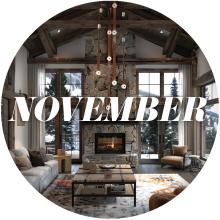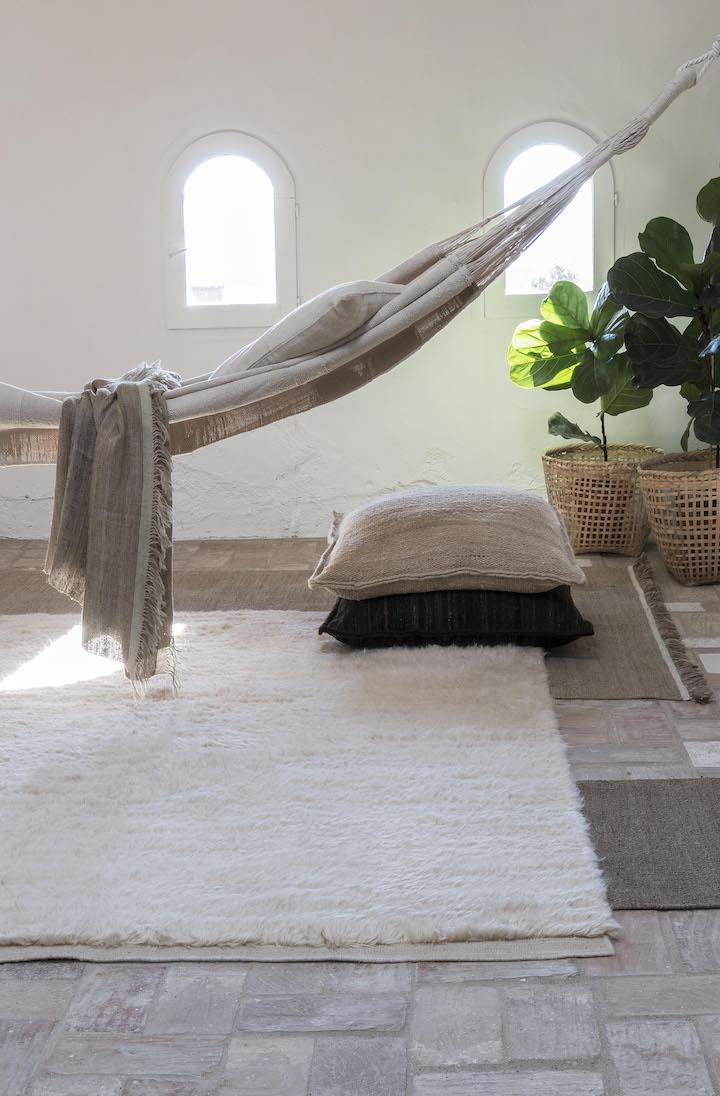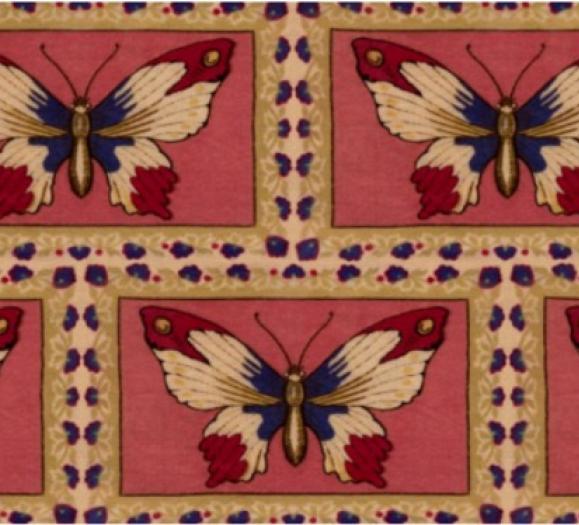Good design involves creating a multi-sensory experience. Sure, we want our rooms to look great, but we can also fill them with items that offer interest beyond the visual. From upholstery to wall art, texture is permeating home decor, and a look around the latest markets indicate that this trend has made it to the floors as well.
“We’re seeing a movement from textured rugs as a niche product into the mainstream,” says Hannah Levine, Head of Product Development for Momeni. “To that end, there is an overall trend toward more natural, organic style, so customers are looking to avoid uniformity and structure in their rugs. We are seeing this as the next step in the longtime downward trend of formality in the home — textured rugs fit perfectly with today’s casual lifestyle.”
To add texture to rugs, a certain degree of craftsmanship is required. Most of the manufacturers we spoke to said the textured rugs they produce are made manually, by hand, noting that machines often cannot produce the same unique textural effects that hand knotting does.
“The most important thing about the textured rugs trend is that it points out the value of the fiber, its thickness, and the quality,” says Nani Marquina, founder and designer for Nanimarquina. “People value craftsmanship and the tradition of rugs, therefore the rugs are bought by those who really appreciate handmade pieces, the irregularities and the natural appearance of fabrics; people who want to surround themselves with natural products that recall nature in its pure state.”
This texture can be presented in a number of ways. Chunky rugs that mimic the look and feel of sweaters or other cozy textiles, with one texture throughout is one option. Another is a single patterned piece with a variety of textures, pile heights and materials.
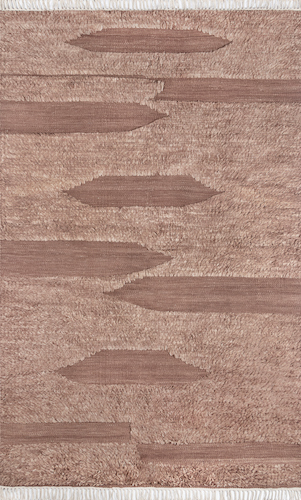
“Texture in rugs is achieved with horizontal wefts,” says Marquina. “The result of these textures is usually a network of vertical and horizontal lines, which mixes fibers of different thicknesses and colors. We achieve this effect by manual weaving.”
Drawing from this desire to surround ourselves with nature, many textural rugs are made from natural materials, such as wool, jute and cotton.
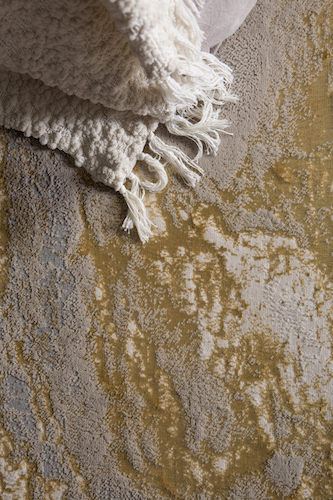
“We harness the power of texture in many ways, but I think it always works best when handmade with natural fibers,” Levine says. “It’s almost impossible to create uniform texture when working with jute, so jute is a natural candidate when texture is the goal. I especially love using undyed wool, as both the natural touch and color variation create visual texture no matter the construction.”
Versatility in Design
The rugs complement a number of design styles and depending on furniture, accessories and other stylistic choices, they can work in any room style.
“I think it doesn’t come down to the rug; it comes down to how you style the room,” says Whitney Hodge, Marketing Manager for Unique Loom. “So you can go with minimalist, you can go with contemporary. If you get that rug in white it becomes very farmhouse-like, so in my opinion, it’s how you style the room and what elements you bring into the room to make the rug stand out and make it fit any style that you’re thinking of.”
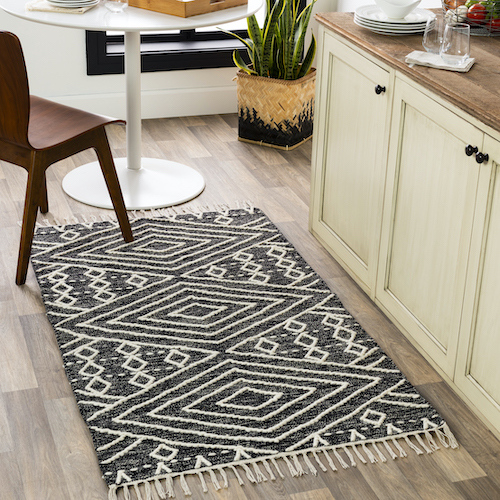
Momeni’s Levine agrees with this sentiment.
“That’s the beauty of texture — it works with any style,” she says. “A textured rug can be the single hint of warmth in an ultramodern space, a palette cleanser in a maximalistic home, or one of many natural elements in a low-key, layered room.”
These layers help with the versatility of the rugs and help them work with multiple design styles.
“I’ve also seen a textured rug in a glam room and I honestly did not think that was possible,” Hodge said. “They took our chunky jute rug and layered it with a one-of-a-kind rug and it instantly became the most glamorous, chic thing I’ve seen. But again, it’s what elements you bring into the room.”
For Steve Sorrow, Jaipur Living’s Director of Product Development, textured rugs provide a nice contrast to minimalist spaces.
“Everyone has a white house, they have white walls, they have everything white — and a few colorful accent pieces,” he says. “Texture is important. You can’t just have everything white. You’ve got to be able to tell where your rug is compared to your sofa and floor. That partly is driving it; people don’t want too much going on.”
Merchandising
The act of purchasing a textured rug is a unique experience in itself. Shopping online for rugs is already a difficult process without the rug in front of the shopper to physically feel, but adding multiple textures to the mix further complicates this. Even in store, short of bending down or taking their shoes off, it can be hard for shoppers to get the full effect of these textured pieces. To combat this, many manufacturers offer samples for retailers to have on hand for customers looking to get up close and personal with the materials. Good online imagery is also key.
“Having the customer touch and feel the product is definitely most important, and we’d love if every customer could do this,” Coradini says. “But if shopping online, we feel it’s very important for us to take multiple close up images to show the depth of the texture.”
Image angle is important as well. “It’s imperative that the main image for solid textured rugs be a detail shot, rather than an overhead rectangular shot, as the customer will almost certainly scroll right past,” Levine says.
Value Added
A few assumptions might be made about a textural rug. One is that there was some kind of unique manufacturing process at work. Another is that the rug might be one of a kind, or have an interesting story behind it. At the very least, it begs to be touched and talked about. This all increases the value of the rug and, by proxy, the space as a whole.
“In general, all textures have value, but when different textures are introduced in the same piece, it brings more richness and originality to the product,” Marquina says.
“Also, flat is just kind of boring,” Sorrow says. “Texture can give rugs a higher perceived value. Whether it’s adding texture through a shrink yarn in a power loomed rug, or a hi-and-low in a hand knot, a hand hooked, or a hand tufted, or a shine versus a dull, it just makes the rug feel like it has more value.”

